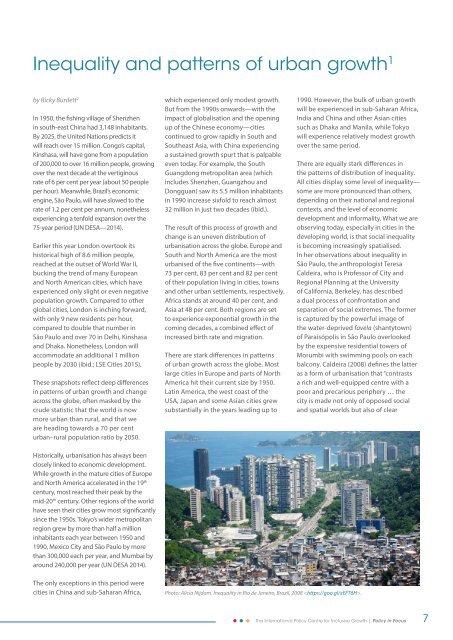A new urban paradigm pathways to sustainable development
PiF37
PiF37
Create successful ePaper yourself
Turn your PDF publications into a flip-book with our unique Google optimized e-Paper software.
Inequality and patterns of <strong>urban</strong> growth 1<br />
by Ricky Burdett 2<br />
In 1950, the fishing village of Shenzhen<br />
in south-east China had 3,148 inhabitants.<br />
By 2025, the United Nations predicts it<br />
will reach over 15 million. Congo’s capital,<br />
Kinshasa, will have gone from a population<br />
of 200,000 <strong>to</strong> over 16 million people, growing<br />
over the next decade at the vertiginous<br />
rate of 6 per cent per year (about 50 people<br />
per hour). Meanwhile, Brazil’s economic<br />
engine, São Paulo, will have slowed <strong>to</strong> the<br />
rate of 1.2 per cent per annum, nonetheless<br />
experiencing a tenfold expansion over the<br />
75-year period (UN DESA—2014).<br />
Earlier this year London over<strong>to</strong>ok its<br />
his<strong>to</strong>rical high of 8.6 million people,<br />
reached at the outset of World War II,<br />
bucking the trend of many European<br />
and North American cities, which have<br />
experienced only slight or even negative<br />
population growth. Compared <strong>to</strong> other<br />
global cities, London is inching forward,<br />
with only 9 <strong>new</strong> residents per hour,<br />
compared <strong>to</strong> double that number in<br />
São Paulo and over 70 in Delhi, Kinshasa<br />
and Dhaka. Nonetheless, London will<br />
accommodate an additional 1 million<br />
people by 2030 (ibid.; LSE Cities 2015).<br />
These snapshots reflect deep differences<br />
in patterns of <strong>urban</strong> growth and change<br />
across the globe, often masked by the<br />
crude statistic that the world is now<br />
more <strong>urban</strong> than rural, and that we<br />
are heading <strong>to</strong>wards a 70 per cent<br />
<strong>urban</strong>–rural population ratio by 2050.<br />
His<strong>to</strong>rically, <strong>urban</strong>isation has always been<br />
closely linked <strong>to</strong> economic <strong>development</strong>.<br />
While growth in the mature cities of Europe<br />
and North America accelerated in the 19 th<br />
century, most reached their peak by the<br />
mid-20 th century. Other regions of the world<br />
have seen their cities grow most significantly<br />
since the 1950s. Tokyo’s wider metropolitan<br />
region grew by more than half a million<br />
inhabitants each year between 1950 and<br />
1990, Mexico City and São Paulo by more<br />
than 300,000 each per year, and Mumbai by<br />
around 240,000 per year (UN DESA 2014).<br />
which experienced only modest growth.<br />
But from the 1990s onwards—with the<br />
impact of globalisation and the opening<br />
up of the Chinese economy—cities<br />
continued <strong>to</strong> grow rapidly in South and<br />
Southeast Asia, with China experiencing<br />
a sustained growth spurt that is palpable<br />
even <strong>to</strong>day. For example, the South<br />
Guangdong metropolitan area (which<br />
includes Shenzhen, Guangzhou and<br />
Dongguan) saw its 5.5 million inhabitants<br />
in 1990 increase sixfold <strong>to</strong> reach almost<br />
32 million in just two decades (ibid.).<br />
The result of this process of growth and<br />
change is an uneven distribution of<br />
<strong>urban</strong>isation across the globe. Europe and<br />
South and North America are the most<br />
<strong>urban</strong>ised of the five continents—with<br />
73 per cent, 83 per cent and 82 per cent<br />
of their population living in cities, <strong>to</strong>wns<br />
and other <strong>urban</strong> settlements, respectively.<br />
Africa stands at around 40 per cent, and<br />
Asia at 48 per cent. Both regions are set<br />
<strong>to</strong> experience exponential growth in the<br />
coming decades, a combined effect of<br />
increased birth rate and migration.<br />
There are stark differences in patterns<br />
of <strong>urban</strong> growth across the globe. Most<br />
large cities in Europe and parts of North<br />
America hit their current size by 1950.<br />
Latin America, the west coast of the<br />
USA, Japan and some Asian cities grew<br />
substantially in the years leading up <strong>to</strong><br />
1990. However, the bulk of <strong>urban</strong> growth<br />
will be experienced in sub-Saharan Africa,<br />
India and China and other Asian cities<br />
such as Dhaka and Manila, while Tokyo<br />
will experience relatively modest growth<br />
over the same period.<br />
There are equally stark differences in<br />
the patterns of distribution of inequality.<br />
All cities display some level of inequality—<br />
some are more pronounced than others,<br />
depending on their national and regional<br />
contexts, and the level of economic<br />
<strong>development</strong> and informality. What we are<br />
observing <strong>to</strong>day, especially in cities in the<br />
developing world, is that social inequality<br />
is becoming increasingly spatialised.<br />
In her observations about inequality in<br />
São Paulo, the anthropologist Teresa<br />
Caldeira, who is Professor of City and<br />
Regional Planning at the University<br />
of California, Berkeley, has described<br />
a dual process of confrontation and<br />
separation of social extremes. The former<br />
is captured by the powerful image of<br />
the water-deprived favela (shanty<strong>to</strong>wn)<br />
of Paraisópolis in São Paulo overlooked<br />
by the expensive residential <strong>to</strong>wers of<br />
Morumbi with swimming pools on each<br />
balcony. Caldeira (2008) defines the latter<br />
as a form of <strong>urban</strong>isation that “contrasts<br />
a rich and well-equipped centre with a<br />
poor and precarious periphery … the<br />
city is made not only of opposed social<br />
and spatial worlds but also of clear<br />
The only exceptions in this period were<br />
cities in China and sub-Saharan Africa,<br />
Pho<strong>to</strong>: Alicia Nijdam. Inequality in Rio de Janeiro, Brazil, 2008 .<br />
The International Policy Centre for Inclusive Growth | Policy in Focus 7


